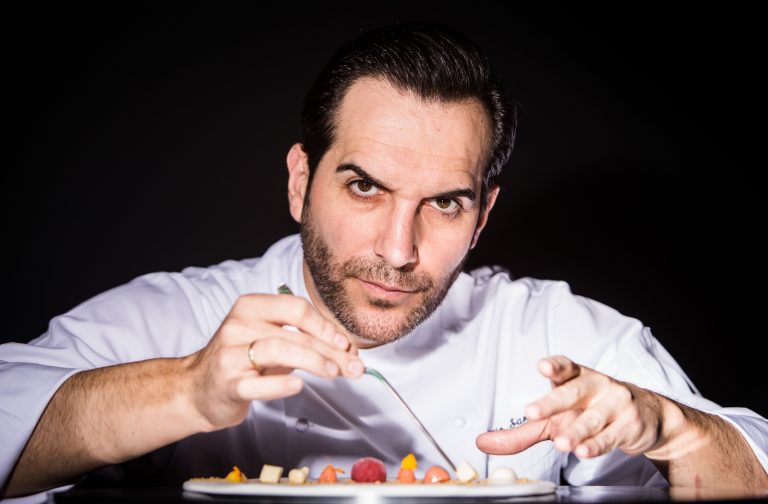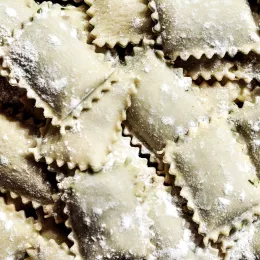In the international culinary scene, Spain is hot right now...white-hot. With a rich culinary history going back hundreds of years and local chefs who continually push the boundaries of modernist cuisine, Spanish cuisine offers a rarely seen depth and diversity — and the culinary community agrees. Three of the top 10 restaurants on the World’s 50 Best Restaurants list call the Iberian peninsula home. In celebration of Spanish cuisine, ICE has partnered with Eat Spain Up to bring two of the country’s best chefs, Mario Sandoval and Toño Perez, to the kitchen classrooms of ICE. This is the second series of courses in our Advanced Culinary Center program.

Chef Mario Sandoval, chef of Coque on the outskirts of Madrid, has led his restaurant in an avant-garde direction, introducing progressive tasting menus where the guests move from the wine cellar to the kitchen to the dining room as the meal progresses through courses.
His efforts were warmly received by critics, diners and the Michelin guide, which awarded Coque its first star in 2004, followed by a second star in 2015. Outside of the restaurant, Chef Mario’s accomplishments include penning five cookbooks and launching an event space, a bakery and a catering company.
In anticipation of welcoming this acclaimed chef to ICE to lead a workshop focused on suckling pig — a traditional Spanish dish — we asked Chef Mario a few questions about the contemporary culinary landscape and his upcoming course at ICE.
You’ve described the food served at your restaurant Coque as “updated Madrid cuisine” — what dishes are central to Madrileño cuisine?
My cooking at Coque interprets the great culinary wealth of the capital of Spain, a city that has always been open to the mixing of different cultures. It shows the culinary cosmopolitanism of Madrid, the first city in Spain where good foreign restaurants started to open.
In my dishes, I use marinades, salted fish and pickled vegetables that show the Madrid heritage. I am also passionate about the products of Madrid — in my kitchen I use products from local farms and orchards where we grow our own vegetables. Utilizing the native varieties of vegetables from Madrid has been very important in my cooking.
Your course will focus on the Spanish suckling pig. I hear that in Segovia, Spain, there are restaurants that make suckling pig so tender that it’s cut with a plate: true or false?
It is completely true and it’s a great tradition started by Meson de Cándido, which continues today with the original owner’s son. The key to tender suckling pig is the technique of baking it in the oven, which has always been fundamental at Coque and what constitutes to this day one of the most recognizable and admired traditional dishes. Our oven is our secret: What makes our suckling pig incredible is the oven — it has endured for over 60 years. Also, the exclusive breed of pig we work with has been genetically selected to become a perfect suckling pig in regard to the tenderness, flavor and texture of the meat.
What can attendees of your class expect to walk away with?
Given the great tradition of this dish in the area of Spain where I live, I would hope to see both traditional and contemporary cooks. They can learn the way we cook the suckling pig — how it is special and very characteristic of our culinary tradition. We cook suckling pig in a way that seeks the maximum in terms of the texture and unique taste of the piglet.
What do you see as differences between American and Spanish food and dining culture?
There is a fundamental difference. The history of Spanish cuisine is based on the Phoenicians, Greeks, Romans and Arabs — great Mediterranean food cultures that the United States does not have. This is reflected in a huge culinary heritage that Spain and the Mediterranean have and which has moved in other ways to the American continent.
The first cookbook was Roman when Spain was under its influence. It is therefore a difference of centuries, more cultural than philosophical. Spain has been influenced by many different civilizations and each has left us a different gastronomic heritage.
Are there any restaurants or food stores you’re looking forward to visiting in New York?
New York is one of the gastronomic capitals of the world for its large and varied range of restaurants and their high quality. I’m not only looking forward to trying the new American cuisine, but I also hope to try the huge variety of restaurants from other cultures that have made New York the mecca for foodies that it is nowadays. As for shopping, it is well-known that New York is one of the cities where you can find all the great products in the world and it will be a pleasure to get lost looking for aromas and flavors.
Hungry for a taste of Spain? Register for our Eat Spain Up courses today!




